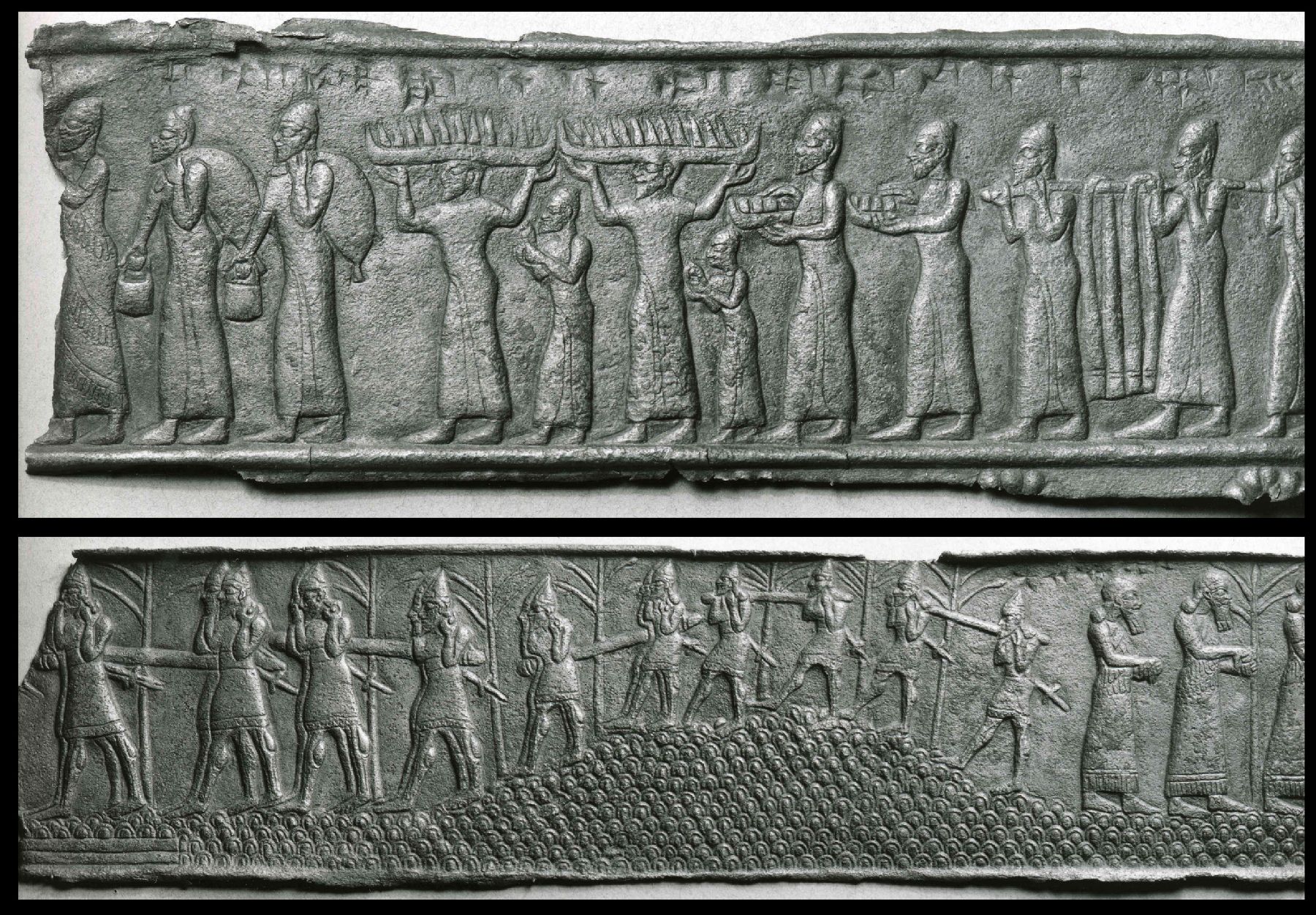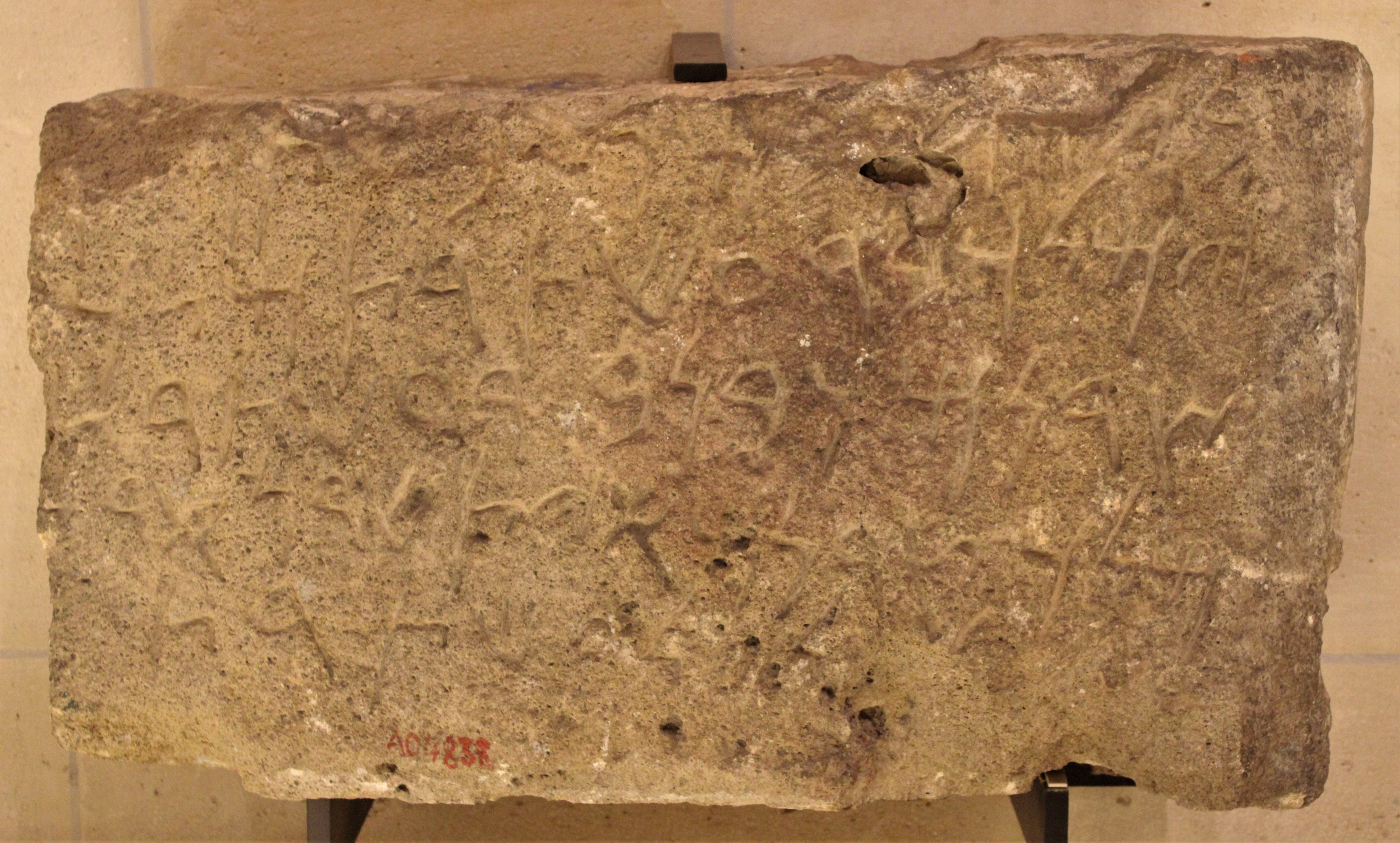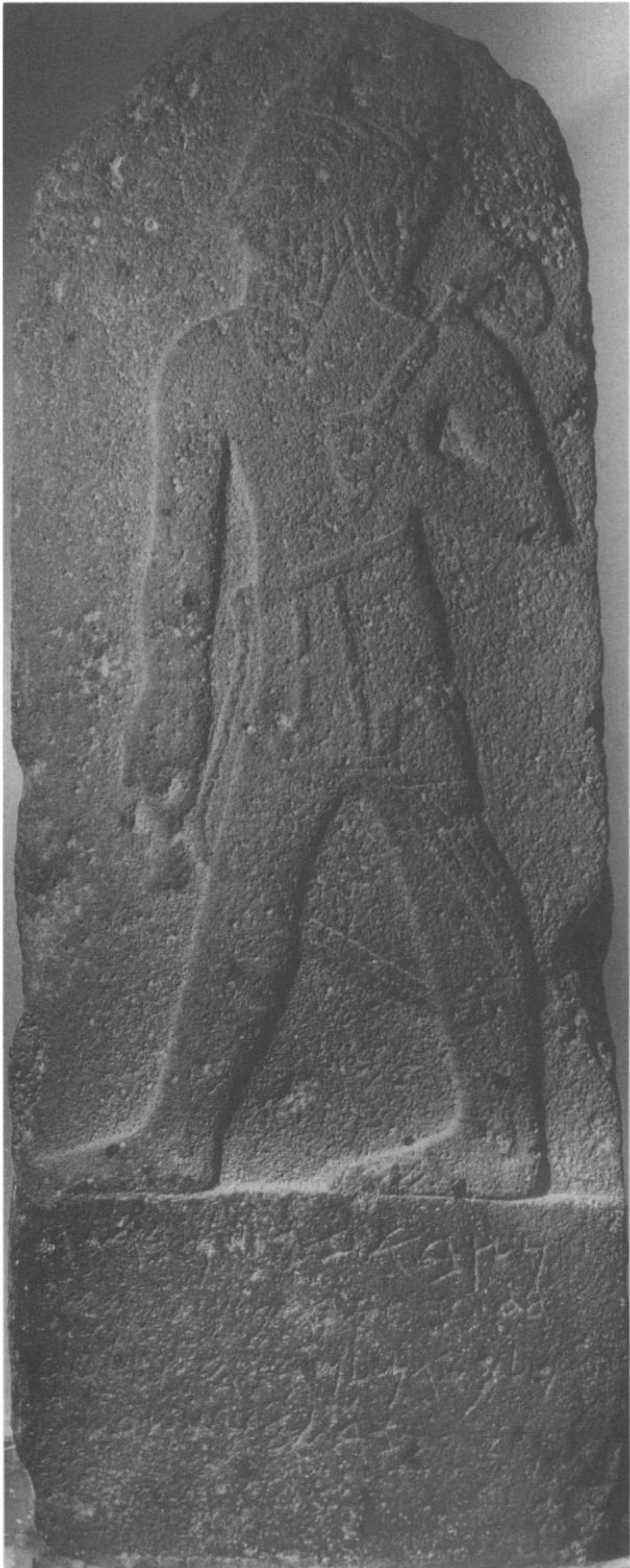|
Yatonmilk
Yatonmilk (, YTNMLK, Romanized also as Yatanmilk, Yaton Milk, Yatan-Milk) was a Phoenician King of Sidon and a vassal to the Achaemenid king of kings Darius I ( 515–486 BC).Elayi 2006, p.31 Epigraphic sources Yatonmilk's name was attested on many building stone-incised dedications dubbed the Bodashtart inscriptions that were found at the Temple of Eshmun in the hinterland of the city of Sidon in Lebanon. Despite being mentioned in the inscriptions, nothing is known about his reign due to the lack of further material or epigraphic evidence.Elayi 2018, p.234Kelly 1987, p.52 Bodashtart, Yatonmilk's father who is dubbed the 'builder king', carried out an extensive expansion and restoration project of the Temple of Eshmun; he left more than thirty dedicatory inscriptions at the temple site. The first phase of the works involved adding a second podium at the base of the temple.Elayi 2006, p.5 During this construction phase inscriptions were carved on the added podium's foun ... [...More Info...] [...Related Items...] OR: [Wikipedia] [Google] [Baidu] |
Bodashtart
Bodashtart (also transliterated Bodʿaštort, meaning "from the hand of Astarte"; ) was a Phoenician ruler, who reigned as King of Sidon ( – ), the grandson of King Eshmunazar I, and a vassal of the Achaemenid Empire. He succeeded his cousin Eshmunazar II to the throne of Sidon, and scholars believe that he was succeeded by his son and proclaimed heir Yatonmilk. Bodashtart was a prolific builder, and his name is attested on some 30 eponymous inscriptions found at the Temple of Eshmun and elsewhere in the hinterland of the city of Sidon in Lebanon. The earliest discovered of Bodashtart's inscriptions was excavated in Sidon in 1858 and was donated to the Louvre. This inscription dates back to the first year of Bodashtart's accession to the throne of Sidon and commemorates the building of a temple to the goddess Astarte. The Temple of Eshmun podium inscriptions were discovered between 1900 and 1922 and are classified into two groups. The inscriptions of the first group, ... [...More Info...] [...Related Items...] OR: [Wikipedia] [Google] [Baidu] |
Bodashtart 1
Bodashtart (also transliterated Bodʿaštort, meaning "from the hand of Astarte"; ) was a Phoenician ruler, who reigned as King of Sidon ( – ), the grandson of King Eshmunazar I, and a vassal of the Achaemenid Empire. He succeeded his cousin Eshmunazar II to the throne of Sidon, and scholars believe that he was succeeded by his son and proclaimed heir Yatonmilk. Bodashtart was a prolific builder, and his name is attested on some 30 eponymous inscriptions found at the Temple of Eshmun and elsewhere in the hinterland of the city of Sidon in Lebanon. The earliest discovered of Bodashtart's inscriptions was excavated in Sidon in 1858 and was donated to the Louvre. This inscription dates back to the first year of Bodashtart's accession to the throne of Sidon and commemorates the building of a temple to the goddess Astarte. The Temple of Eshmun podium inscriptions were discovered between 1900 and 1922 and are classified into two groups. The inscriptions of the first group, k ... [...More Info...] [...Related Items...] OR: [Wikipedia] [Google] [Baidu] |
Bodashtart Inscriptions
The Bodashtart inscriptions are a well-known group of between 22–24 Phoenician inscriptions from the 6th century BC referring to King Bodashtart.Bordreuil, 1990, "L'exemple le plus impressionnant est certainement celui des nombreuses dedicaces de Bodachtart decouvertes dans le temple d'Echmoun pres de Saida et conservees aujourd'hui dans plusieurs musees, auxquelles s'ajoutent trois exemplaires demeures in situ... Le nombre des inscriptions de Bodachtart mises au jour et repertories est a ce jour d'au moins dix-neuf (KAI 15 + 16) dont neuf (KAI 16) mentionnent Yatonmilk patronyme de Bodachtart. Il faut y ajouter RES 767 K in situ et les trois mentionnes par G. Contenau, soit quatre, a moins que RES 767 K ne soit la premiere mentionnee par G. Contenau, ce qui reduirait le supplement a trois. De plus on ne sait si l'estampage de RES 289 C correspond a un exemplaire connu par ailleurs ou s'il est le seul temoignage d'un exemplaire aujourd'hui disparu. A ma connaissance le nombre d'ins ... [...More Info...] [...Related Items...] OR: [Wikipedia] [Google] [Baidu] |
King Of Sidon
The King of Sidon was the ruler of Sidon, an ancient Phoenician city in what is now Lebanon. Scholars have pieced together the fragmented list from various archaeological finds since the 19th century. Egyptian period * c.1700s BC Zimrida * c. 1300s BC Zimredda of Sidon / Zimrida IISidon : a study in oriental history 1907, Appendix 1: Kings of Sidon, p. 155-156. * c. 1300s BC Iab-nilud Assyrian period * 680–677 BCPersian period Eshmunazar Dynasty * 575–550 BC |
Kings Of Sidon
The King of Sidon was the ruler of Sidon, an ancient Phoenician city in what is now Lebanon. Scholars have pieced together the fragmented list from various archaeological finds since the 19th century. Egyptian period * c.1700s BC Zimrida * c. 1300s BC Zimredda of Sidon / Zimrida IISidon : a study in oriental history 1907, Appendix 1: Kings of Sidon, p. 155-156. * c. 1300s BC Iab-nilud Assyrian period * 680–677 BCPersian period Eshmunazar Dynasty * 575–550 BC |
Temple Of Eshmun
The Temple of Eshmun ( ar, معبد أشمون) is an ancient place of worship dedicated to Eshmun, the Phoenician god of healing. It is located near the Awali river, northeast of Sidon in southwestern Lebanon. The site was occupied from the 7th century BC to the 8th century AD, suggesting an integrated relationship with the nearby city of Sidon. Although originally constructed by Sidonian king Eshmunazar II in the Achaemenid era ( 529–333 BC) to celebrate the city's recovered wealth and stature, the temple complex was greatly expanded by Bodashtart, Yatan-milk and later monarchs. Because the continued expansion spanned many centuries of alternating independence and foreign hegemony, the sanctuary features a wealth of different architectural and decorative styles and influences. The sanctuary consists of an esplanade and a grand court limited by a huge limestone terrace wall that supports a monumental podium which was once topped by Eshmun's Greco-Persian style marble t ... [...More Info...] [...Related Items...] OR: [Wikipedia] [Google] [Baidu] |
Eshmunazar II Sarcophagus
The Eshmunazar II sarcophagus is a 6th-century BC sarcophagus unearthed in 1855 in the "Phoenician Necropolis", a hypogeum (underground tomb) complex in the southern area of the city of Sidon in modern-day Lebanon. The sarcophagus was discovered by members of the French consulate in Sidon and was donated to the Louvre. The Eshmunazar II sarcophagus has two sets of Canaanite and Aramaic inscriptions, Phoenician inscriptions, one on its lid and the other on its trough, under the sarcophagus head. The lid engraving was of great significance upon its discovery; it was the first Phoenician language inscription to be discovered in Phoenicia, Phoenicia proper, the most detailed Phoenician text ever found anywhere up to that point, and is today the second longest extant Phoenician inscription after the one discovered at Karatepe bilingual, Karatepe. Eshmunazar II (Phoenician: ', a theophoric name meaning 'Eshmun helps') was a Phoenician King of Sidon and the son of King Tabnit. His sa ... [...More Info...] [...Related Items...] OR: [Wikipedia] [Google] [Baidu] |
6th-century BC Rulers
The 6th century is the period from 501 through 600 in line with the Julian calendar. In the West, the century marks the end of Classical Antiquity and the beginning of the Middle Ages. The collapse of the Western Roman Empire late in the previous century left Europe fractured into many small Germanic kingdoms competing fiercely for land and wealth. From the upheaval the Franks rose to prominence and carved out a sizeable domain covering much of modern France and Germany. Meanwhile, the surviving Eastern Roman Empire began to expand under Emperor Justinian, who recaptured North Africa from the Vandals and attempted fully to recover Italy as well, in the hope of reinstating Roman control over the lands once ruled by the Western Roman Empire. In its second Golden Age, the Sassanid Empire reached the peak of its power under Khosrau I in the 6th century.Roberts, J: "History of the World.". Penguin, 1994. The classical Gupta Empire of Northern India, largely overrun by the Huna, ended ... [...More Info...] [...Related Items...] OR: [Wikipedia] [Google] [Baidu] |
Melkart
Melqart (also Melkarth or Melicarthus) was the tutelary god of the Phoenician city-state of Tyre and a major deity in the Phoenician and Punic pantheons. Often titled the "Lord of Tyre" ('' Ba‘al Ṣūr''), he was also known as the Son of Baal or El (the Ruler of the Universe), King of the Underworld, and Protector of the Universe. He symbolized the annual cycle of vegetation and was associated with the Phoenician maternal goddess Astarte. Melqart was typically depicted as a bearded figure, dressed only in a rounded hat and loincloth. Reflecting his dual role as both protector of the world and ruler of the underworld, he was often shown holding an Egyptian ankh or lotus flower as a symbol of life and a fenestrated axe as a symbol of death. As Tyrian trade and settlement expanded, Melqart became venerated in Phoenician and Punic cultures across the Mediterranean, especially its colonies of Carthage and Cadiz. During the high point of Phoenician civilization between 1000 ... [...More Info...] [...Related Items...] OR: [Wikipedia] [Google] [Baidu] |
Phoenician Language
Phoenician ( ) is an extinct language, extinct Canaanite languages, Canaanite Semitic languages, Semitic language originally spoken in the region surrounding the cities of Tyre, Lebanon, Tyre and Sidon. Extensive Tyro-Sidonian trade and commercial dominance led to Phoenician becoming a lingua franca of the maritime Mediterranean Sea, Mediterranean during the Iron Age. The Phoenician alphabet History of the Greek alphabet, spread to Greece during this period, where it became the source of all modern Alphabet#European_alphabets, European scripts. The area in which Phoenician was spoken includes the northern Levant and, at least as a prestige language, Anatolia, specifically the areas now including Syria, Lebanon, parts of Cyprus and some adjacent areas of Turkey. It was also spoken in the area of Phoenician colonies, Phoenician colonization along the coasts of the southwestern Mediterranean Sea, including those of modern Tunisia, Morocco, Libya and Algeria as well as Malta, the we ... [...More Info...] [...Related Items...] OR: [Wikipedia] [Google] [Baidu] |
Eshmun
Eshmun (or Eshmoun, less accurately Esmun or Esmoun; phn, 𐤀𐤔𐤌𐤍 '; akk, 𒅀𒋢𒈬𒉡 ''Yasumunu'') was a Phoenician god of healing and the tutelary god of Sidon. History This god was known at least from the Iron Age period at Sidon and was worshipped also in Tyre, Beirut, Cyprus, Sardinia, and in Carthage where the site of Eshmun's temple is now occupied by the acropolium of Carthage. According to Eusebius of Caesarea, Phoenician author Sanchuniathon wrote that Sydyk, 'The Righteous', first fathered seven sons equated with the Greek Cabeiri or Dioscuri, no mother named, and then afterwards fathered an eighth son by one of the seven Titanides or Artemides. (See Kotharat). The name ''Eshmun'' appears to mean 'the Eighth'. The Neo-Platonist Damascius also stated Photius (''Bibliotheca'' Codex 242) summarizes Damascius as saying further that Asclepius of Beirut was a youth who was fond of hunting. He was seen by the goddess Astronoë (thought by many scholars to ... [...More Info...] [...Related Items...] OR: [Wikipedia] [Google] [Baidu] |







